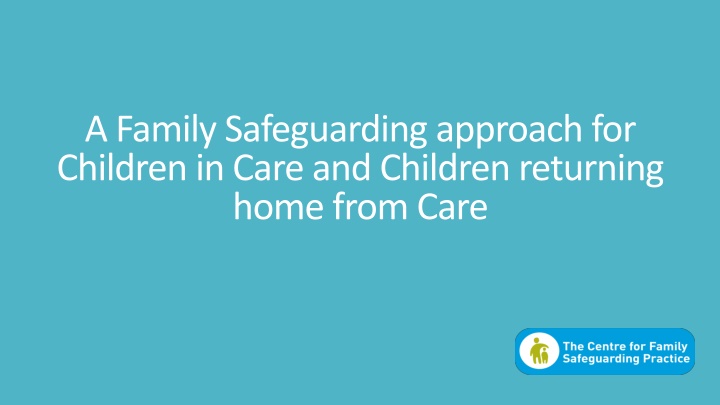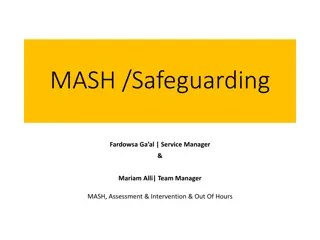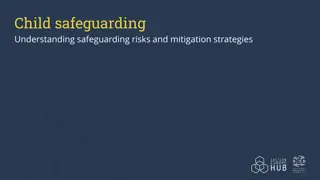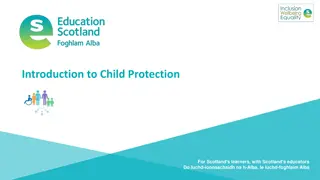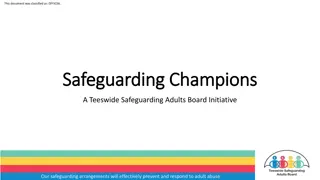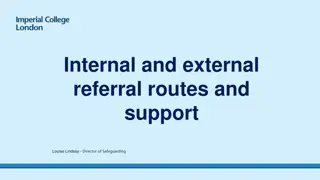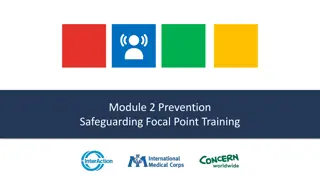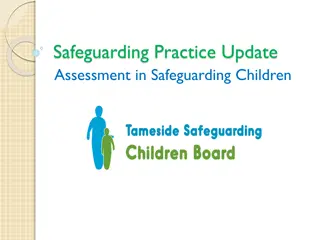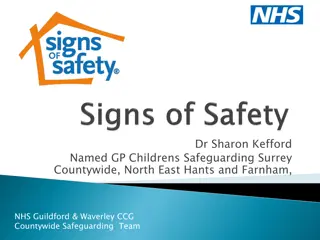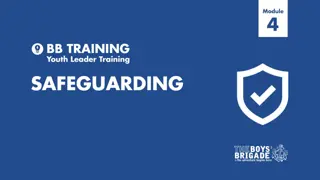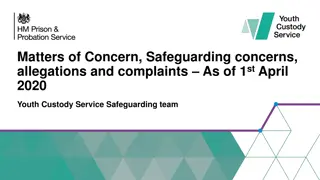A Family Safeguarding Approach for Children in Care
Families often come into contact with children's social care due to parenting under adversarial conditions rather than causing harm. The need for a change in vision and values underpinning family safeguarding duties is crucial, emphasizing the importance of helping families raise their children. Lady Hale's quote from the Supreme Court judgment highlights the complexities of determining when state intervention is necessary in cases of emotional or psychological harm. The provision of services for children in need and their families is a duty that local authorities must fulfill to safeguard and promote children's welfare.
Download Presentation

Please find below an Image/Link to download the presentation.
The content on the website is provided AS IS for your information and personal use only. It may not be sold, licensed, or shared on other websites without obtaining consent from the author.If you encounter any issues during the download, it is possible that the publisher has removed the file from their server.
You are allowed to download the files provided on this website for personal or commercial use, subject to the condition that they are used lawfully. All files are the property of their respective owners.
The content on the website is provided AS IS for your information and personal use only. It may not be sold, licensed, or shared on other websites without obtaining consent from the author.
E N D
Presentation Transcript
A Family Safeguarding approach for Children in Care and Children returning home from Care
Need for change Vision and values underpinning Family Safeguarding Duties in Law Children and Family Rights Exploring implications for practice Language and Culture Agenda
In the majority of cases, families become involved with children s social care because they are parenting in conditions of adversity, rather than because they have caused or are likely to cause significant harm to their children. We have a shared obligation to help families raise their children. The Case for Change The independent review of children s social care https://childrenssocialcare.independent-review.uk/
Quote from Lady Hale in the Supreme Court judgment Re B (2013) This case raises some profound questions about the scope of courts' powers to take away children from their birth families when what is feared is, not physical abuse or neglect, but emotional or psychological harm. We are all frail human beings, with our fair share of unattractive character traits, which sometimes manifest themselves in bad behaviours which may be copied by our children. But the State does not and cannot take away the children of all the people who commit crimes, who abuse alcohol or drugs, who suffer from physical or mental illnesses or disabilities, or who espouse anti-social political or religious beliefs... How is the law to distinguish between emotional or psychological harm, which warrants the compulsory intervention of the State, and the normal and natural tendency of children to grow up to be and behave like their parents? Added to this is the problem that the harm which is feared may take many years to materialise, if indeed it ever does. Every child is an individual, with her own character and personality. Many children are remarkably resilient. They do not all inherit their parents' less attractive characters or copy their less attractive behaviours. Indeed some will consciously reject them. They have many other positive influences in their lives which can help them to resist the negative, whether it is their schools, their friends, or other people around them. How confident do we have to be that a child will indeed suffer harm because of her parents' character and behaviour before we separate them for good? . a court can only separate a child from her parents if satisfied that it is necessary to do so, that nothing else will do . Link to full judgment
Provision of services for children in need & their families: (1) It shall be the general duty of every local authority (a) to safeguard and promote the welfare of children within their area who are in need; and Part Three Children Act 1989 (b) so far as is consistent with that duty, to promote the upbringing of such children by their families, by providing a range and level of services appropriate to those children s needs Any service provided by an authority may be provided for any member of his family, if it is provided with a view to safeguarding or promoting the child s welfare
What are your views about children What are your views about children returning home from care? returning home from care? Mentimeter
Child protection system Child protection system adversarial and too focused adversarial and too focused on risk on risk - - CA 1989 requires us CA 1989 requires us to provide services to to provide services to promote upbringing of promote upbringing of children in their families children in their families System does not support System does not support open, honest relationships open, honest relationships with families or partnership with families or partnership working working Number of children have Number of children have doubled in care over the last doubled in care over the last 20 years (CAFCASS,2018) 20 years (CAFCASS,2018) Children want to Children want to maintain strong links maintain strong links with their family with their family Human Rights and Human Rights and empowerment vs empowerment vs oppressive practice that oppressive practice that blames parents blames parents Moving away from Moving away from identifying and identifying and managing risks to managing risks to meeting family needs meeting family needs Need for Need for change change Identity Identity Needs of families are not Needs of families are not static and the likelihood static and the likelihood of harm can change over of harm can change over time time Impact of children Impact of children returning home from returning home from care or as care leavers care or as care leavers - - with little preparation with little preparation Are children still in care Are children still in care for the right reasons? for the right reasons? Reviewing Thresholds Reviewing Thresholds Families change Families change Impact of unsuccessful Impact of unsuccessful return home for children return home for children and families and families Children may not be Children may not be better off in care in the better off in care in the longer term longer term Disproportionality, Disproportionality, diversity and inclusion diversity and inclusion
Many care experienced people leave care and Many care experienced people leave care and live happy and fulfilling lives, and care can live happy and fulfilling lives, and care can O Outcomes utcomes for for care care experienced experienced people people provide the lifeline which leads to a better life provide the lifeline which leads to a better life than they would have had if they remained at than they would have had if they remained at home. Care can be a positive, transformational home. Care can be a positive, transformational and life saving experience. and life saving experience. (Care Review,2022)
Over-represented in mental health and prison settings More likely to die prematurely O Outcomes utcomes for for care care experienced experienced people people Lower educational attainment & subsequent disadvantage More likely to be unemployed/in low skill jobs More likely to have their children removed by CS (Rahilly & Hendry 2014) Negative outcomes linked to lack of support, isolation, loneliness (Munro 2011) Relationships key to emotional wellbeing, quality and continuity Care often breaks children s existing relationships with family & friends (Care Review 2013)
Our primary duty to children is to safeguard them from actual or likely Our primary duty to children is to safeguard them from actual or likely significant harm and promote their upbringing by their families significant harm and promote their upbringing by their families Vision Vision and values of values of Family Family Safeguarding Safeguarding approach approach and We do this by: We do this by: assessing needs & providing actual services to meet needs of children & their families taking a restorative approach to working with families, building, maintaining and repairing relationships where harm has been caused caring for children until it s safe for them to go home fulfilling our duties to share PR and promote contact/family time developing MI skills to promote engagement of families and create change believing all people have intrinsic worth and a right to help and support
Motivational Motivational Interviewing Interviewing To improve engagement and encourage change. MI is described as a collaborative conversation style for strengthening a person s own motivation and commitment to change
Mentimeter What are the rights of parents What are the rights of parents when children are accommodated when children are accommodated in terms of Section 20 and Section in terms of Section 20 and Section 31 of the Children Act 1989? 31 of the Children Act 1989?
How inclusive are we of parents? How inclusive are we of parents? Meeting the needs of Meeting the needs of parents whilst children parents whilst children are in care are in care Care planning and Care planning and Children Looked After Children Looked After Process Process After a child comes After a child comes into care into care Before children come Before children come into care. into care. Quality of family Quality of family time/contact time/contact Relationships with Relationships with Foster Foster Carers/Placements, Carers/Placements, Social Workers and Social Workers and professionals involved professionals involved Return home Return home assessment and assessment and decision making decision making Support after leaving Support after leaving Care Care Preparing child and Preparing child and family for return home family for return home Transition home Transition home
Had I only known I could get my children back, I would have got help sooner I can help my children understand why they are in care A parent s perspective I only got support when the decision was made for my children to return home What support do parents get to address their own issues when What support do parents get to address their own issues when their children come into care? their children come into care?
MS Teams Chat When children leave our care where do they most commonly go?
For most For most children, returning children, returninghome after being looked after is a common outcome . This is for children who after is a common outcome . This is for children who have been in care and as care leavers (Wilkins and have been in care and as care leavers (Wilkins and Farmer, 2015;Wade,2008) Farmer, 2015;Wade,2008) home after being looked What does this mean for practice? What does this mean for practice?
My social worker was openly judgmental about my parents. Like, I get they had made mistakes, but they were still my parents. I think they should have been trying to repair the relationships, not push them apart even further. They should be neutral and figure out what works best for all involved. Young Person s view This young person returned home at 16. (Woodworth et al, Community Care,2019 ) What are your thoughts on this young person s What are your thoughts on this young person s experience? experience?
Group Discussion Group Discussion Group 1 Group 1 Why should we work in partnership with parents when children come into care and what are the benefits of this for the child? Group 2 How and when should we start to plan for children to return home from Care?
Language Matters
How do we develop culturally responsive practice?
The legal framework requires Local Authorities to return children home unless this is not consistent with their welfare. Children returning home to parents can happen at the end of proceedings or later. Care Crisis Review, (2018) on children returning home from care It is an important permanence option for children overall, and research evidence tells us that it requires adequate planning and support if it is to be sustained. There are particular risks for children who have been maltreated, if the parents problems that led to children being removed have not been or are not being addressed, in which case there is increased likelihood of children coming back into proceedings. It is about detailed and clear plans that anticipate the impact of return home The importance of social work that is high in intensity, based on continuing relationships with trusted workers, and with a focus on strengthening fragile relationships between family members and using multi-disciplinary team approaches for as long as they are needed
If most children in our care If most children in our care return home to their families, return home to their families, what will you do to make this what will you do to make this successful? successful? Mentimeter
Further Reading The Children Act 1989 The Children Act 1989 Final Report - The Independent Review of Children's Social Care (independent-review.uk) Improving the chances of successful reunification for children who return home from care: a rapid evidence review (whatworks-csc.org.uk) The Care Crisis Review: Options for Change The Care Crisis Review: Options for Change - - Family Rights Group (frg.org.uk) Family Rights Group (frg.org.uk) Lecture by Lord Justice McFarlane: Holding the risk Lecture by Lord Justice McFarlane: Holding the risk - - The balance between child protection and the right to family life (judicia The balance between child protection and the right to family life (judiciary.uk) ry.uk) Sheffield_Solutions_Clear_Blue_Water_Full_Report.pdf Sheffield_Solutions_Clear_Blue_Water_Full_Report.pdf How safe are our children? 2020 | NSPCC Learning How safe are our children? 2020 | NSPCC Learning Family Rights Group Family Rights Group Lifelong Links: Lifelong Links: https://frg.org.uk/lifelong https://frg.org.uk/lifelong- -links/ links/ Reunification: an evidence Reunification: an evidence- -informed framework for return home practice (nspcc.org.uk) informed framework for return home practice (nspcc.org.uk) The Care Planning, Placement and Case Review (England) Regulations 2010 (legislation.gov.uk) The Care Planning, Placement and Case Review (England) Regulations 2010 (legislation.gov.uk) Racial-and-ethnic-disparities-in-childrens-social-care.pdf (independent-review.uk) Ethnicity and children s social care (publishing.service.gov.uk)
Contact us: FSProjectTeam@Hertfordshire.go v.uk
